 Pain Francais or French bread was this months challenge and was selected by joint hosts Mary from The Sour Dough and Sara from I Like To Cook.
Pain Francais or French bread was this months challenge and was selected by joint hosts Mary from The Sour Dough and Sara from I Like To Cook.Baking some French bread might not sound like much of a challenge at first but don’t be fooled, French bread actually requires a lot of time, patience and skill. The general process turned out to be quite straightforward but it was putting those process into action that was the challenging part. The recipe instructions alone were 12 pages long – yes 12 pages and they had condensed it for us!! I don’t think I have ever made a recipe with so many stages. This was partly down to the in depth detail of the recipe and also thanks Mary and Sara who had added their own helped hints and tips along the way. These proved most helped – thanks girls.
The dough is very wet and sticky to work with, keeping it on the move proved the best way to deal with it and its stickiness becomes more manageable as time goes on. The bread goes through 3-4 rises which take in total nearly 10 hours, so this is not the kind of bread to make in a hurry – but with a little time and patience its really worth the wait. The end bread had a thin crisp golden brown crust and an airy centre that had just the right amount of chew to it. French bread likes hot humid atmospheres and this is achieved by giving the bread a sauna as it bakes by throwing in a mug full of water into the base of the oven and then slamming the door shut, trapping the hot steam inside. Just remember to stand back when you next open the oven door or you will get a face full of steam too.

We were given the choice of what style/shape of French bread we wanted to bake from the list below. The recipe would allow us to make:
3 - baguettes (24” x 2”) or batards (16” x 3”) or
3 - baguettes (24” x 2”) or batards (16” x 3”) or
6 – short loaves, ficelles, 12 – 16” x 2” or
3 – round loaves, boules, 7 – 8” in diameter or
12 – round or oval rolls, petits pains or
1 – large round or oval loaf, pain de menage or miche; pain boulot
I opted for 2 short loaves (ficelles) and 8 petits pains.
I opted for 2 short loaves (ficelles) and 8 petits pains.
 The petits pains turned out very cute and were perfect for dipping into soup, but my favourites were the ficelles which looked (to me) more traditional and how I always imagine French bread to look. They also had a higher chewy inside to crust ratio than the petits pains which I liked. Thanks Mary and Sara for the challenge it was a lot of and has given me a great respect for professional French bread bakers and the work and time involved in producing such a wonderful bread.
The petits pains turned out very cute and were perfect for dipping into soup, but my favourites were the ficelles which looked (to me) more traditional and how I always imagine French bread to look. They also had a higher chewy inside to crust ratio than the petits pains which I liked. Thanks Mary and Sara for the challenge it was a lot of and has given me a great respect for professional French bread bakers and the work and time involved in producing such a wonderful bread.Please visit Mary and Sara’s blogs for the recipe and don’t forget to visit the blogroll to read about fellow Darking Bakers breads.



 (Recipe adapted from Australian Women’s Weekly Magazine)
(Recipe adapted from Australian Women’s Weekly Magazine) Meanwhile, prepare the icing. Place the egg white and sugar into a large glass bowl suspended over a pan of gently simmering water.
Meanwhile, prepare the icing. Place the egg white and sugar into a large glass bowl suspended over a pan of gently simmering water.
 1) Apples – there is something so satisfying about biting into a crisp fresh apple. The crunch sound as you bite into it and the sweet refreshing juice that fills your mouth.
1) Apples – there is something so satisfying about biting into a crisp fresh apple. The crunch sound as you bite into it and the sweet refreshing juice that fills your mouth. 1) Baking - what a surprise!
1) Baking - what a surprise! 1) My laptop – I would be lost without it
1) My laptop – I would be lost without it
 Ingredients
Ingredients



 For the cake
For the cake Melt the 40g of white chocolate in the microwave, stirring every 30 seconds.
Melt the 40g of white chocolate in the microwave, stirring every 30 seconds. Preheat the oven to 170C
Preheat the oven to 170C

 Ingredients
Ingredients
 Ingredients
Ingredients What do you do when you have an excess of fruit? Make pies? Crumbles? Freeze it? Give it away? I make jam. I usually always make my own jam as I believe you simply cannot but as good a jam as homemade, no matter how expensive. I admit you can get some nicely flavoured ones, but on the whole I generally find they are too sweet and can start to crystalise a month after opening. I like to taste and see the fruit in my jam and be able to identify the fruits by its taste. Plus there is something satisfying about making your own jam, it’s very traditional and the aroma of a steaming pot of bubbling fruit is one I associate with my mum and grandmother.
What do you do when you have an excess of fruit? Make pies? Crumbles? Freeze it? Give it away? I make jam. I usually always make my own jam as I believe you simply cannot but as good a jam as homemade, no matter how expensive. I admit you can get some nicely flavoured ones, but on the whole I generally find they are too sweet and can start to crystalise a month after opening. I like to taste and see the fruit in my jam and be able to identify the fruits by its taste. Plus there is something satisfying about making your own jam, it’s very traditional and the aroma of a steaming pot of bubbling fruit is one I associate with my mum and grandmother.
 Ingredients
Ingredients




